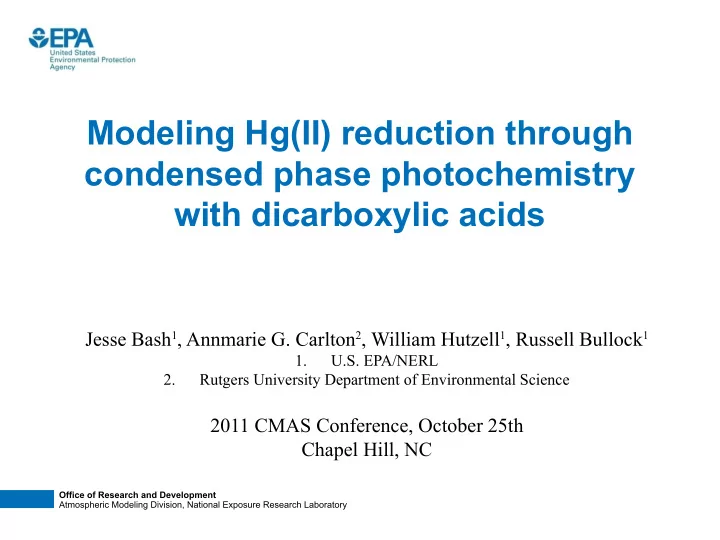

Modeling Hg(II) reduction through condensed phase photochemistry with dicarboxylic acids Jesse Bash 1 , Annmarie G. Carlton 2 , William Hutzell 1 , Russell Bullock 1 1. U.S. EPA/NERL 2. Rutgers University Department of Environmental Science 2011 CMAS Conference, October 25th Chapel Hill, NC Office of Research and Development Atmospheric Modeling Division, National Exposure Research Laboratory
Outline • Overview of aqueous phase reduction and motivation • Model simulations – Condensed phase reduction schemes • None, HO 2 . , C2-C4 dicarboxylic acids (DCA) – July-August and January-February simulations • Evaluation against MDN observations – Domain wide statistics – Regional differences • Conclusions 2 Office of Research and Development Atmospheric Modeling Division, National Exposure Research Laboratory
Atmospheric Hg • Mercury deposition is the primary source of mercury contamination in ecosystems – Reactive gas phase mercury, Hg(II), deposits readily – Gaseous elemental mercury, Hg(0), not as apt to deposit through wet and dry pathways – Atmospheric Hg is primarily (~99%) present as Hg(0) • In soils or the water column Hg can be transformed into organic Hg compounds – Potent neurotoxins • Hg(II) is reduced in cloud droplet to form Hg(0) – Though mechanisms are not well-understood Hg(II) Hg(II) is reduced to Hg0 during Hg(II) aqueous processing, but there is debate about the mechanism(s). Hg(0) 3 Office of Research and Development Hg(0) Atmospheric Modeling Division, National Exposure Research Laboratory
Motivation • Most atmospheric models parameterize condensed phase Hg(II) by HO 2 . or scaled to OH – Reduction by HO 2 . has been shown to be improbable under environmental conditions – Scaled rates do not represent real atmospheric chemical processes • Recent laboratory experiments (Si and Ariya, 2008; Bartels- Rausch et al 2011) and observations (Wang and Hintelmann, 2009) indicate photoinduced reduction of Hg(II) by DCA – Second order photoreduction of Hg(II) observed with oxalic, malonic and succinic acids • A reduction mechanism proposed by Si and Ariya, 2008 is investigated in a regional scale modeling study 4 Office of Research and Development Atmospheric Modeling Division, National Exposure Research Laboratory
Model Simulations • Changes to aqueous phase Hg chemistry – CMAQ estimates cloud secondary organic aerosols (SOA) • Oxalic acid is the dominant product of glyoxal oxidation and dominates over other DCAs – Same model run but the cloud SOA (primarily oxalic acid) reduction pathway instead of HO 2 . • 2002 January-February and July-August model runs – No condensed phase, HO 2 . and DCA reduction mechanism cases simulated – Evaluated against mercury deposition network (MDN) wet deposition observations 5 Office of Research and Development Atmospheric Modeling Division, National Exposure Research Laboratory
6 Domain Wide Evaluation • Reduction scheme is necessary to capture observations • DCA mechanism reduced bias and error in wet deposition estimates in July- August simulations • DCA mechanism increased bias and error in wet deposition estimates in January- February simulations Office of Research and Development Atmospheric Modeling Division, National Exposure Research Laboratory
7 Domain Wide Evaluation r MB ME NMB NME MM5 Jan. 0.815 4.2 mm mon -1 16.9 mm mon -1 9.0% 37.5% Precip. -Feb. Jul. 0.729 33.7 mm mon -1 59.3 mm mon -1 74.4% 132.3% -Aug. No Jan. 0.726 0.423 μg m -2 mon -1 0.471 μg m -2 mon -1 111% 123% Reduction -Feb. Jul. 0.787 1.233 μg m -2 mon -1 1.234 μg m -2 mon -1 117% 117% -Aug. HO2 Jan. 0.718 -0.014 μg m -2 mon -1 0.149 μg m -2 mon -1 -4% 39% Reduction -Feb. Jul. 0.655 -0.428 μg m -2 mon -1 0.508 μg m -2 mon -1 -41% 48% -Aug. DCA Jan. 0.714 0.139 μg m -2 mon -1 0.231 μg m -2 mon -1 36% 60% Reduction -Feb. Jul. 0.738 -0.184 μg m -2 mon -1 0.381 μg m -2 mon -1 -17% 36% -Aug. Office of Research and Development Atmospheric Modeling Division, National Exposure Research Laboratory
8 Jan.-Feb. Hg Wet Deposition • Less variability between model simulations than July-August simulations • DCA over predicted wet deposition in Gulf States • Jan.-Feb. wet deposition more sensitive to boundary condition Hg(II) concentrations Office of Research and Development Atmospheric Modeling Division, National Exposure Research Laboratory
9 Jan.-Feb. Precipitation • Precipitation is over estimated in the North East Office of Research and Development Atmospheric Modeling Division, National Exposure Research Laboratory
10 July-August Hg Wet Deposition • DCA mechanism reduces under prediction in Southeast and Midwest • Increases wet deposition in the west and over the oceans where observations are sparse • No reduction scheme over predicts wet deposition domain wide Office of Research and Development Atmospheric Modeling Division, National Exposure Research Laboratory
11 July-August Precipitation • Precipitation is over estimated in the south and around Indiana • Bias in TX and IA correspond to model over estimates in the DCA and no reduction cases Office of Research and Development Atmospheric Modeling Division, National Exposure Research Laboratory
12 Conclusions • Condensed phase reduction of Hg(II) by DCA has been parameterized in CMAQ – More probable than HO 2 . and more physically descriptive than scaled reduction mechanisms • Improved July-August total Hg wet deposition performance when compared to MDN observations – When Hg total deposition peaks in most locations • Some degredation in January and February wet deposition performance – Absolute increase in Jan. & Feb. bias is less than the improvements in July & Aug. – May be related to model boundary conditions • Available in CMAQ 5.0 Multipollutant Office of Research and Development Atmospheric Modeling Division, National Exposure Research Laboratory
13 Questions? Office of Research and Development Atmospheric Modeling Division, National Exposure Research Laboratory
Recommend
More recommend